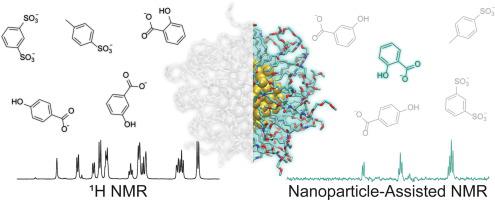当前位置:
X-MOL 学术
›
Prog. Nucl. Magn. Reson. Spectrosc.
›
论文详情
Our official English website, www.x-mol.net, welcomes your feedback! (Note: you will need to create a separate account there.)
Nanoparticle-assisted NMR spectroscopy: A chemosensing perspective
Progress in Nuclear Magnetic Resonance Spectroscopy ( IF 6.1 ) Pub Date : 2020-04-01 , DOI: 10.1016/j.pnmrs.2019.12.001 Federico De Biasi 1 , Fabrizio Mancin 1 , Federico Rastrelli 1
Progress in Nuclear Magnetic Resonance Spectroscopy ( IF 6.1 ) Pub Date : 2020-04-01 , DOI: 10.1016/j.pnmrs.2019.12.001 Federico De Biasi 1 , Fabrizio Mancin 1 , Federico Rastrelli 1
Affiliation

|
Sensing methodologies for the detection of target compounds in mixtures are important in many different contexts, ranging from medical diagnosis to environmental analysis and quality assessment. Ideally, such detection methods should allow for both identification and quantification of the targets, minimizing the possibility of false positives. With very few exceptions, most of the available sensing techniques rely on the selective interaction of the analyte with some detector, which in turn produces a signal as a result of the interaction. This approach hence provides indirect information on the targets, whose identity is generally ensured by comparison with known standards, if available, or by the selectivity of the sensor system itself. Pursuing a different approach, NMR chemosensing aims at generating signals directly from the analytes, in the form of a (complete) NMR spectrum. In this way, not only are the targets unequivocally identified, but it also becomes possible to identify and assign the structures of unknown species. In this review we show how relaxation- and diffusion-based NMR techniques, assisted by appropriate nanoparticles, can be used to edit the 1H NMR spectrum of a mixture and extract the signals of specific target compounds. Monolayer-protected nanoparticles, in particular those made from gold, are well suited to this task because they provide a versatile, protein-size support to build or incorporate supramolecular receptors. Remarkably, the self-organized and multifunctional nature of the nanoparticle coating allows exploitation of different kinds of non-covalent interactions, to provide tailored binding sites for virtually any class of molecules. From the NMR standpoint, the reduced translational and rotational diffusion rates of bulky nanoparticles offer a way to manipulate the states of the monolayer spins and build a reservoir of magnetization that can be selectively transferred to the interacting analytes. In addition, the low correlation time and the enhanced rigidity of the coating molecules (due to their grafting and crowding on the particle surface) promote efficient spin diffusion, useful in saturation transfer experiments. The optimized combination of NMR experiments and nanoreceptors can ultimately allow the detection of relevant analytes in the micromolar concentration range, paving the way to applications in the diagnostic field and beyond.
中文翻译:

纳米粒子辅助核磁共振波谱:化学传感视角
用于检测混合物中目标化合物的传感方法在许多不同的环境中都很重要,从医学诊断到环境分析和质量评估。理想情况下,此类检测方法应允许识别和量化目标,从而最大限度地减少误报的可能性。除了极少数例外,大多数可用的传感技术依赖于分析物与某些检测器的选择性相互作用,而检测器又会因相互作用而产生信号。因此,这种方法提供了关于目标的间接信息,其身份通常通过与已知标准(如果可用)或传感器系统本身的选择性进行比较来确保。追求不同的方法,核磁共振化学传感旨在直接从分析物产生信号,以(完整的)核磁共振谱的形式。通过这种方式,不仅可以明确识别目标,而且还可以识别和分配未知物种的结构。在这篇综述中,我们展示了基于弛豫和扩散的 NMR 技术如何在适当的纳米粒子的辅助下用于编辑混合物的 1H NMR 谱并提取特定目标化合物的信号。单层保护的纳米粒子,特别是那些由金制成的纳米粒子,非常适合这项任务,因为它们提供了一种多功能的蛋白质大小支持来构建或合并超分子受体。值得注意的是,纳米粒子涂层的自组织和多功能性质允许利用不同种类的非共价相互作用,为几乎任何类别的分子提供定制的结合位点。从 NMR 的角度来看,体积大的纳米粒子降低的平移和旋转扩散速率提供了一种方法来操纵单层自旋的状态并建立一个磁化库,可以选择性地转移到相互作用的分析物上。此外,涂层分子的低相关时间和增强的刚性(由于它们在粒子表面的接枝和拥挤)促进了有效的自旋扩散,在饱和转移实验中很有用。核磁共振实验和纳米受体的优化组合最终可以检测微摩尔浓度范围内的相关分析物,为诊断领域及其他领域的应用铺平道路。庞大的纳米粒子降低的平移和旋转扩散速率提供了一种方法来操纵单层自旋的状态并建立一个磁化库,可以选择性地转移到相互作用的分析物上。此外,涂层分子的低相关时间和增强的刚性(由于它们在粒子表面的接枝和拥挤)促进了有效的自旋扩散,在饱和转移实验中很有用。核磁共振实验和纳米受体的优化组合最终可以检测微摩尔浓度范围内的相关分析物,为诊断领域及其他领域的应用铺平道路。庞大的纳米粒子降低的平移和旋转扩散速率提供了一种方法来操纵单层自旋的状态并建立一个磁化库,可以选择性地转移到相互作用的分析物上。此外,涂层分子的低相关时间和增强的刚性(由于它们在粒子表面的接枝和拥挤)促进了有效的自旋扩散,在饱和转移实验中很有用。核磁共振实验和纳米受体的优化组合最终可以检测微摩尔浓度范围内的相关分析物,为诊断领域及其他领域的应用铺平道路。涂层分子的低相关时间和增强的刚性(由于它们在颗粒表面接枝和拥挤)促进了有效的自旋扩散,在饱和转移实验中很有用。核磁共振实验和纳米受体的优化组合最终可以检测微摩尔浓度范围内的相关分析物,为诊断领域及其他领域的应用铺平道路。涂层分子的低相关时间和增强的刚性(由于它们在颗粒表面接枝和拥挤)促进了有效的自旋扩散,在饱和转移实验中很有用。核磁共振实验和纳米受体的优化组合最终可以检测微摩尔浓度范围内的相关分析物,为诊断领域及其他领域的应用铺平道路。
更新日期:2020-04-01
中文翻译:

纳米粒子辅助核磁共振波谱:化学传感视角
用于检测混合物中目标化合物的传感方法在许多不同的环境中都很重要,从医学诊断到环境分析和质量评估。理想情况下,此类检测方法应允许识别和量化目标,从而最大限度地减少误报的可能性。除了极少数例外,大多数可用的传感技术依赖于分析物与某些检测器的选择性相互作用,而检测器又会因相互作用而产生信号。因此,这种方法提供了关于目标的间接信息,其身份通常通过与已知标准(如果可用)或传感器系统本身的选择性进行比较来确保。追求不同的方法,核磁共振化学传感旨在直接从分析物产生信号,以(完整的)核磁共振谱的形式。通过这种方式,不仅可以明确识别目标,而且还可以识别和分配未知物种的结构。在这篇综述中,我们展示了基于弛豫和扩散的 NMR 技术如何在适当的纳米粒子的辅助下用于编辑混合物的 1H NMR 谱并提取特定目标化合物的信号。单层保护的纳米粒子,特别是那些由金制成的纳米粒子,非常适合这项任务,因为它们提供了一种多功能的蛋白质大小支持来构建或合并超分子受体。值得注意的是,纳米粒子涂层的自组织和多功能性质允许利用不同种类的非共价相互作用,为几乎任何类别的分子提供定制的结合位点。从 NMR 的角度来看,体积大的纳米粒子降低的平移和旋转扩散速率提供了一种方法来操纵单层自旋的状态并建立一个磁化库,可以选择性地转移到相互作用的分析物上。此外,涂层分子的低相关时间和增强的刚性(由于它们在粒子表面的接枝和拥挤)促进了有效的自旋扩散,在饱和转移实验中很有用。核磁共振实验和纳米受体的优化组合最终可以检测微摩尔浓度范围内的相关分析物,为诊断领域及其他领域的应用铺平道路。庞大的纳米粒子降低的平移和旋转扩散速率提供了一种方法来操纵单层自旋的状态并建立一个磁化库,可以选择性地转移到相互作用的分析物上。此外,涂层分子的低相关时间和增强的刚性(由于它们在粒子表面的接枝和拥挤)促进了有效的自旋扩散,在饱和转移实验中很有用。核磁共振实验和纳米受体的优化组合最终可以检测微摩尔浓度范围内的相关分析物,为诊断领域及其他领域的应用铺平道路。庞大的纳米粒子降低的平移和旋转扩散速率提供了一种方法来操纵单层自旋的状态并建立一个磁化库,可以选择性地转移到相互作用的分析物上。此外,涂层分子的低相关时间和增强的刚性(由于它们在粒子表面的接枝和拥挤)促进了有效的自旋扩散,在饱和转移实验中很有用。核磁共振实验和纳米受体的优化组合最终可以检测微摩尔浓度范围内的相关分析物,为诊断领域及其他领域的应用铺平道路。涂层分子的低相关时间和增强的刚性(由于它们在颗粒表面接枝和拥挤)促进了有效的自旋扩散,在饱和转移实验中很有用。核磁共振实验和纳米受体的优化组合最终可以检测微摩尔浓度范围内的相关分析物,为诊断领域及其他领域的应用铺平道路。涂层分子的低相关时间和增强的刚性(由于它们在颗粒表面接枝和拥挤)促进了有效的自旋扩散,在饱和转移实验中很有用。核磁共振实验和纳米受体的优化组合最终可以检测微摩尔浓度范围内的相关分析物,为诊断领域及其他领域的应用铺平道路。



























 京公网安备 11010802027423号
京公网安备 11010802027423号